In a concerning incident at Wyoming’s Grand Teton National Park, a 35-year-old man from Massachusetts was seriously injured after being attacked by a grizzly bear. The event occurred on Sunday afternoon on Signal Mountain, prompting park officials to close the area temporarily. This decision reflects parks’ escalating challenges in managing interactions between wildlife and humans as grizzly populations grow.
The victim, whose name has not been disclosed by the authorities, was hiking on Signal Mountain when he unexpectedly encountered two grizzlies. The situation quickly became dire, necessitating an emergency response. Park rangers promptly administered first aid, and the man was airlifted by helicopter to a nearby hospital. He is expected to recover, but the specifics of his injuries remain under wraps, highlighting the often unpredictable nature of wild animal encounters.
Signal Mountain, renowned for its panoramic views at an elevation of 7,700 feet, is a popular destination within Grand Teton National Park. Following the attack, the park closed the trail leading to the mountain’s overlook and the adjacent road. This closure is part of a broader strategy to ensure visitor safety while the incident is investigated and to prevent further encounters during the peak of the busy tourist season.
This is not an isolated incident; it underscores a more significant trend across North America, where the habitats of humans and wildlife overlap. As grizzly populations have rebounded due to successful conservation efforts, so have the occurrences of human-bear conflicts. The recovery of these bears is a conservation success story. Yet, it brings the complex challenge of managing coexistence in areas like Grand Teton and the neighboring Yellowstone National Park.
In response to the growing number of bear-related incidents, park officials have intensified their efforts to educate the public. They stress the importance of maintaining a safe distance from all wildlife—specifically recommending that visitors stay at least 100 yards away from bears and wolves. Additionally, carrying bear spray is strongly advised as it has proven to be an effective deterrent in critical situations.
Moreover, park authorities are doubling down on enforcing proper food storage techniques. Visitors are reminded to secure food in bear-proof containers and dispose of garbage in designated receptacles to minimize odors that could attract bears to populated areas. These preventive measures are crucial in limiting unintended interactions and maintaining safety.
Educational programs for visitors have become a cornerstone of the park’s strategy to manage wildlife interactions. These initiatives include workshops on bear behavior, safety protocols while hiking in bear country, and the correct use of bear spray. The goal is to equip visitors with the knowledge and tools they need to enjoy the park’s natural beauty safely without endangering themselves or the wildlife.
The recent bear attack has also triggered a review of safety protocols within the park. Officials are evaluating whether additional signage is needed on trails, whether there should be more frequent updates on wildlife activity to visitors, and if adjustments are necessary to train park staff to handle wildlife emergencies effectively.
Signal Mountain’s temporary closure will remain in effect until park officials deem it safe to reopen. They monitor the situation closely, assess wildlife activity, and ensure all safety measures are in place. Visitors planning to travel to the park are encouraged to check updates on closures and safety guidelines through the park’s official communication channels.
As we move forward, the management of Grand Teton National Park is faced with the delicate balance of promoting access to natural areas while ensuring the safety of both visitors and wildlife. This incident is a poignant reminder of the inherent risks of entering these wild landscapes. It highlights the need for continued vigilance, respect for nature, and adherence to safety guidelines to prevent future incidents.
Park authorities’ commitment to conservation and education is more critical than ever as they navigate the challenges posed by increasing visitors and a growing wildlife population. Through comprehensive management strategies and public cooperation, creating a safe environment where humans and wildlife can thrive is possible.







